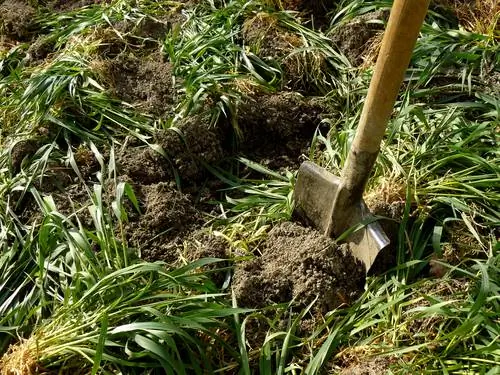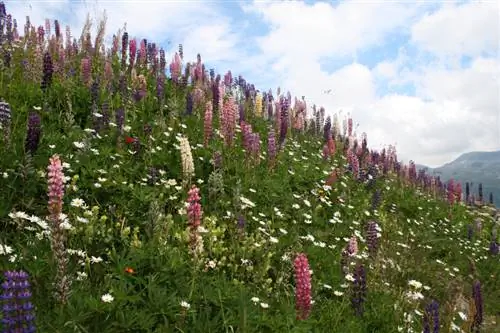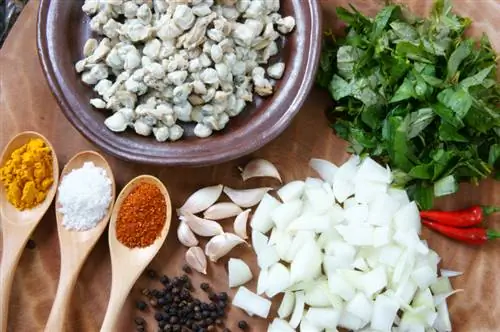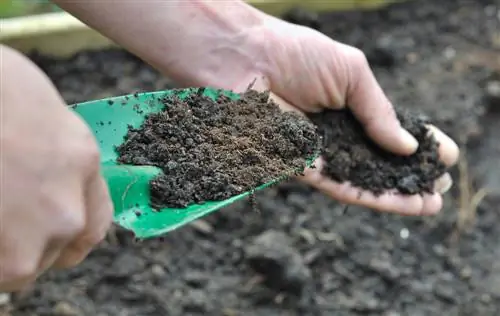- Author admin [email protected].
- Public 2023-12-26 14:17.
- Last modified 2025-06-01 06:02.
You should not leave the garden floor open, especially over the winter months, as this contributes to soil erosion. Instead, sow suitable plants for green manure that protect the soil and also enrich it with nutrients through their plant mass. However, this effective form of soil improvement must be well planned.

What is green manure?
Green manure is a proven method in natural garden management and organic farming. It is primarily carried out to cover the soil and to improve it by incorporating fresh or wilted plants into the soil that have been sown specifically for this purpose. The farmer calls these plants “cover crops” because they are not harvested but are returned to the natural nutrient cycle.
It is best to cut green manure plants shortly before or during flowering so that no seeds form and you end up with a colorful flower meadow instead of a vegetable patch. The roots of the green plants remain in the ground, gradually decompose and loosen the soil. The cuttings, on the other hand, are left until new sowing, where they serve as mulching material and compost.
Which plants are suitable for green manure?
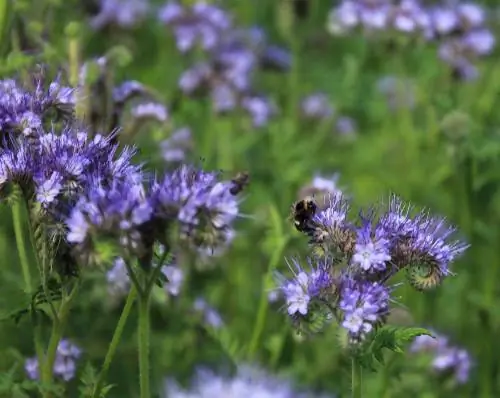
Phacelia not only offers great green manure, but is also very popular with bees
Like all plants, green manure plants also have their own specific requirements when it comes to location and soil. Legumes, i.e. legumes such as vetches, beans, peas, lupins and clover, are particularly important for this purpose, as their roots can bind nitrogen from the air and hold it in the soil. This is made possible by so-called nodule bacteria on the roots, the Rhizobium bacteria.
The following table clearly lists these and other important green manure plants, their location requirements and their effect on soil he alth.
| Art | Latin name | Sowing | Location and soil | Effect on the soil |
|---|---|---|---|---|
| Faba bean | Vicia faba | February to July | good for dry soils | Deep rooter for loose soil, good nitrogen collector |
| Alexandrine Clover | Trifolium alexandrinum | April to October | sunny, moist ground | Nitrogen collector, suppresses weeds |
| Bee Friend | Phacelia | April to October | very good for nutrient-poor soils | Bee pasture, effective against nematodes |
| Blue Flax | Linum usitatissimum | April to June | also for partially shaded locations | Deep roots for soil loosening |
| Blue lupine, fertilizer lupine | Lupinus angustifolius | April to October | also for partially shaded locations | valuable nitrogen collector, deep rooter for loose soil |
| Buckwheat | Fagopyrum esculentum | May to August | for low-lime sand and heather soils, including moor soils | fruit-neutral (knotweed), bee pasture |
| Hornpodenklee (Common horned trefoil) | Lotus corniculatus | March to August | very good for poor, dry and lime-rich soils | Deep-rooting plant for loose soil, good nitrogen collector, valuable bee pasture |
| oil radish | Raphanus sativus var. oleiformis | April to September | very good for compacted soils | Deep roots for loose soil, not before or after cabbage plants |
| Pannonian vetch | Vicia pannonica | August to October | for sunny locations | good nitrogen collector, for winter cultivation |
| Red Clover | Trifolium pratense | March to September | for deep, fresh soil | Deep-rooting for loose soil, fast-growing, nitrogen-producing |
| Student flower | Tagetes | May to June | very good for partially shaded locations and moist soils | Deep roots for loose soil, bee pasture, fights nematodes |
| White mustard (also yellow mustard) | Sinapis alba | March to September | very good for compacted soils | Deep roots for loose soil, not before or after cabbage plants |
| White Clover | Trifolium repens | February to October | for sunny locations | good nitrogen forming |
| Winter rapeseed | Brassica napus | May to September | for nutrient-rich soils | good for loosening the soil, for overwintering, not before or after cabbage plants |
Excursus
Spinach as green manure
The hardy spinach (bot. Spinacia oleracea) is also suitable for green manure, but only to a limited extent. The vegetables are suitable as a pre-culture and should be sown early in the year - between March and May. The strong taproots of the fast-growing plant loosen the soil well and prepare it for suitable subsequent crops. Spinach contains saponins that promote nutrient absorption in other plants, improve soil life and thus indirectly water storage, and shade the soil and thus prevent it from drying out. That's why spinach is very suitable for mixed cultivation with almost all other vegetables.
However, the leafy vegetables also have a disadvantage: they accumulate nitrates in the soil and should therefore not be cultivated together with heavy feeders such as peppers, brassicas and celery. Other vegetables from the same plant family - beetroot, Good Henry, chard, garden cress and rocket - are also not suitable for mixed culture and crop rotation.
If the soil is mulched with spinach, this attracts earthworms - these in turn are essential for the production of valuable, nutrient-rich humus.
Sowing and timing
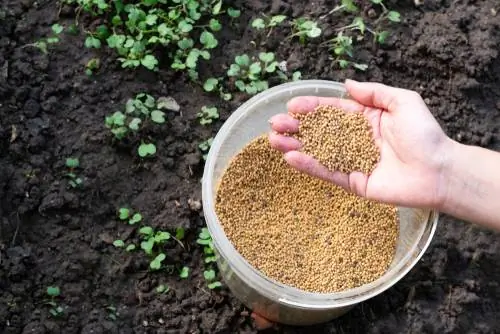
Winter-hardy green manure such as mustard can be sown in March
The green manure is sown between March and October, depending on the plant species selected. The best way to do this is as follows:
- First remove any weeds that may be growing with a rake.
- Work the soil thoroughly with the hoe and loosen the upper layers of soil.
- Crush the clods of earth with a rake.
- Sow the seeds widely on the prepared area.
- Alternatively, you can also use a spreader if you have one.
- Then work the seeds flat into the ground with a wide hay rake.
- Finally, go over the seed area with a lawn roller, if available.
- Water the area when it is dry.
Most seeds will germinate in about six to 14 days, depending on the plant type.
Pre-sowing
Green manure spread in early spring between February and March is called pre-sowing. It is primarily used to nourish and activate the microorganisms living in the soil after winter. For this form of green manure, choose frost-tolerant plant species such as spinach (bot. Spinacia oleracea), lamb's lettuce (bot. Valerianella locusta), phacelia (bot. Phacelia tanacetifolia) or yellow mustard (bot. Sinapis alba).
These plants remain on the area until you plant or sow the actual crops. The green manure can be left between the rows of vegetables in the bed as so-called undersown crops and is only cut occasionally if it grows too much.
Under and intermediate sowing
Undercrops and cover crops are intended to cover the ground between various perennial vegetable crops such as corn, tomatoes, cabbage or berries. Here you spread the green manure plants as soon as the crops have grown. Low-growing and annual plants such as nasturtiums (bot. Tropaeolum), marigolds (bot. Tagetes erecta), marigold (bot. Calendula officinalis) or purslane (bot. Portulaca oleracea). A pleasant side effect of these plants is that you can also use them in the kitchen or for the medicine cabinet.
Reseeding
After the harvest in late summer, the vegetable beds can be covered with reseeding. You can sow these two to three weeks before the harvest - for example as undersowing between the rows - so that the fallow phase is no longer necessary. Most of the plants used for this are not hardy and die with the first frost. The effect is intentional because the soil remains protected and loose under the frozen plant mass. Instead of frost-sensitive species such as yellow mustard, phacelia or sunflower, you can also plant hardy leafy vegetables such as spinach and lamb's lettuce. However, this variant is only recommended if the beds are to be planted late in the following year.
When and how do you have to incorporate the green manure?
Apart from the overwintering species, the green manure plants remain on the beds for around five to ten weeks and are then mowed down. However, do not clear away the plant remains, but leave them where they are as mulch. They rot there and enter the soil as humus. Only low-growing green manure plants such as garden cress and lamb's lettuce are not mowed, but are worked directly into the soil from a height of approx. five centimeters.
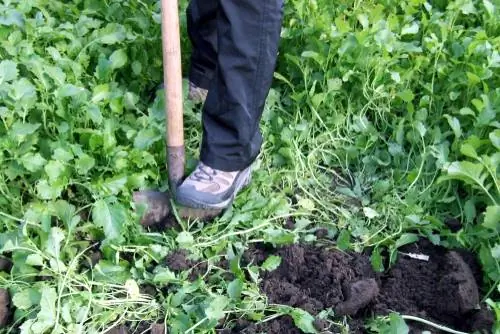
The green manure is simply worked into the soil
Mowing before seeds are ripe
Also make sure to mow the plants before the seeds ripen, otherwise you will have a problem with masses of wildly germinating plants the following year. Green manure plants that are not hardy, on the other hand, usually freeze before the seeds ripen and can therefore remain standing. Here you only mow the remains in spring and work them flat into the ground. The bed can be reordered after another three to four weeks.
Incorporate green manure plants into the soil
Mowing is done with a scythe, a brush cutter or a powerful lawnmower. The latter is the device of choice, especially when it comes to a mulching mower. Green manure plants that are chopped up equally well rot more quickly. However, do not work the mown plants into the ground straight away, but rather let them dry for a few days. This is especially true for species with a lot of leaf mass, as otherwise they can rot in the ground. Green manure plants with woody stems (e.g. sunflowers), on the other hand, are not incorporated at all, but are composted well chopped up in the compost. Here the decomposition process is simply too long to incorporate the remains into the soil straight away.
You have to pay attention to this when using green manure
When selecting plants, there are some tips to consider regarding crop rotation or mixed culture. For example, representatives of the same plant family must under no circumstances be grown one after the other in one area, otherwise certain pathogens will accumulate in the soil and threaten the subsequent harvest. Typical examples of this are nematodes and clubroot. Furthermore, especially in the case of legumes, excretions from the roots lead to self-intolerance.
Observe crop rotation
For this reason, take a break from cultivation of three to four years before cultivating a representative of a specific plant family on the area again. Specifically, this means: If you want to grow cruciferous vegetables such as cabbage, radishes or radishes in your vegetable patch, you must not sow rapeseed, oilseed radish or mustard as green manure. However, if peas and beans are planned, lupins, vetches or clover should not be used as green manure.
Phacelia for the vegetable garden
Phacelia, on the other hand, is ideal for the garden because it is not closely related to any vegetables and therefore there are no interactions. The same applies to buckwheat, a knotweed plant that should not be mixed with rhubarb. Marigold, also known as marigold, helps against root-damaging nematodes.
How does green manure work?
Green manure is less about actual fertilization and more about a soil improvement measure. Harvested vegetable beds, but also fruit beds and other garden areas benefit from green manure in several ways. Depending on the plant selection and the desired benefit, this can be sown as a main crop, catch crop or undersown or, although rarely, planted.
Green manure in the vegetable patch
Green manure is particularly useful before or after the cultivation of heavily consuming vegetable plants such as tomatoes, peppers, potatoes, artichokes, melons, etc., as these plants leach out the soil despite additional fertilization. Through soil improvement measures as well as sensible crop rotation and mixed cultivation, the soil can recover more quickly and crop yields can increase.
A harvested bed has been replanted? The harvested peas were chopped very small with a spade and are used as green manure. On top there is a thin layer of compost enriched with primary rock powder and horn shavings. 16 white beets were placed in the outer circle of the bed, 8 kohlrabi Lanro in the inner circle, 4 colored chard in the middle circle and 1 yellow chard in the middle? I'm curious what it will look like in a few weeks? new bed green manure white beets kohlrabi lanro colorful chard mangold bed cultivation foundation primordial rock flour horn shavings fertilizer fertilization organic vegetables vegetable garden vegetable cultivation vegetable bed vegetables organic stefanshobbygarden
A post shared by Stefans-Hobby-Garten (@stefans_hobby_garten) on Jul 8, 2019 at 10:57am PDT
Green manure for soil improvement
Unfavorable soil conditions, such as the soil in new development areas that is compacted by heavy construction machinery, can be improved by green manure, as the plants use their roots to loosen the soil and thus protect it from siltation. Phacelia (bee willow), winter rapeseed and yellow lupine are particularly suitable for loosening the soil. At the same time, these plants increase the valuable humus content through their rotting plant mass.
Green manure in the orchard
In the orchard or orchard, flowering green manure plants - sown as undersowing - attract many insects, which in turn pollinate the apple and pear trees. This also contributes to a rich fruit harvest, especially since the trees benefit greatly from additional nutrients.
Green manure has these advantages for the garden
Green manure has - apart from those already mentioned - many positive effects on the garden. The dense carpet of plants not only suppresses the growth of unwanted weeds, but also prevents soil erosion and the washing out of nutrients from the fallow soil. This is no longer unprotected thanks to the targeted planting.
Enrichment of the soil with nitrogen
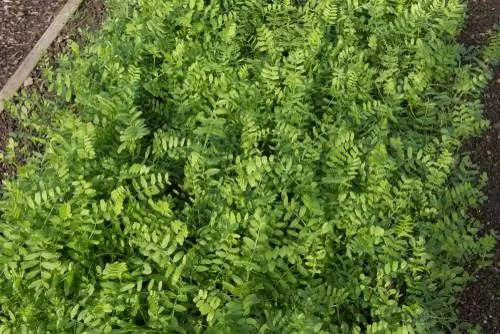
Leguminoses enrich the soil with nitrogen
The green manure plants not only preserve the nutrients already contained in the soil, but even enrich them with fresh nitrogen. Legumes use the nodule bacteria in their roots to filter nitrogen out of the air and later pass it on to the following plants after it has been incorporated into the soil and decomposed. This means that sweet peas, beans, peas and lupins practically act as natural long-term fertilizers.
Loosening compacted soils
Green manure plants with deep roots - for example alfalfa and oil radish - are also able to loosen up heavily compacted soil and thus make it usable in the first place. This property is particularly important in new development areas, where the soil is often very compacted due to construction work using heavy machinery.
Enrichment with humus material
Other species - for example winter vetch or phacelia - are perfect for enriching depleted and / or sandy soils with humus and thus making them fertile again. These plant species develop a lot of leaf and flower matter, which composts in the soil and thereby activates the soil organisms.
Benefits of green manure at a glance:
- rapid greening of fallow areas
- Protection of the soil from the effects of the weather and thus from erosion
- deep loosening and aeration of the soil
- Improving soil structure
- Enriching the garden soil with nutrients
- Activation of the soil organisms that are important for humus formation
- Absorption of nutrients (especially nitrogen) from the air
- Harnessing nutrients from deeper soil layers
- Suppression of weed growth
- Cuttings make valuable mulch material
- Insect pasture using flowering green manure plants
- some green manure plants fight nematodes (roundworms) and fungal diseases in the soil
The following video shows very clearly how the soil can be improved with green manure and what you specifically need to consider:

Frequently asked questions
Can you also sow summer flowers and use them as green manure?
Of course, you can also use summer flowers for green manure, especially since you're not just doing something good for your garden: the flowering plants attract numerous insects and serve as valuable pasture for bees, bumblebees, butterflies and other animals. This nutritional function is all the more important the later it is in the year, as many insects no longer find enough food from the summer months onwards. Borage, sweet peas, marigolds, marigolds and sunflowers are particularly suitable for this purpose.
However, flowering green manure also has a disadvantage: As soon as the seeds ripen, you will have colorful flowers in the garden in the following years - and usually exactly where you don't want them. For this reason, you must mow down the plants in good time before the seeds ripen. Also pay attention to crop rotation, which is particularly important in the vegetable garden: under no circumstances should you plant plants from the same plant family in the same place one after the other. This promotes disease! For example, marigolds and sunflowers must not be grown before or after salads.
Which green manure plants make the soil particularly loose?
The cultivation of green manure plants has different effects on the garden soil, depending on the plant species selected. Solid and compacted soils, which are unfortunately typical in new development areas due to construction machinery, cannot only be loosened with mechanical work. To loosen the soil, also plant deep-rooted plants such as bitter lupins (or lupins in general), oil radishes or sunflowers - their roots also reach the lower layers of the soil and thus ensure better ventilation and permeability.
Which green manure plants are particularly suitable for the vegetable garden?
Choosing the right green manure for the vegetable garden is not that easy, after all, for plant he alth reasons, plants from the same family must not be grown one after the other. However, this means that many of the otherwise recommended green manure plants are no longer necessary, because cruciferous plants such as mustard, cress or rapeseed do not get along with brassicas as well as radishes or radishes - clubroot would be the unpleasant result. However, there are also well-suited green manure plants that are true all-rounders and can actually be grown at any time: Phacelia is one of them, but also winter cereals such as winter barley or winter rye.
Why are winter grains problematic in the vegetable garden?
Winter grains as green manure plants have many advantages: The seeds are cheap and as grains, the various types are not related to any vegetables and can therefore be sown without hesitation. However, winter rye and the like have one disadvantage: they develop a very dense root system, which can only be removed or incorporated in the spring with a lot of strength and effort.
Tip
If you want to use legumes such as clover or lupine for green manure, fertilize the soil with a little rock powder or algae lime before sowing. The natural material promotes the activity of the nodule bacteria in the roots of the plants.

